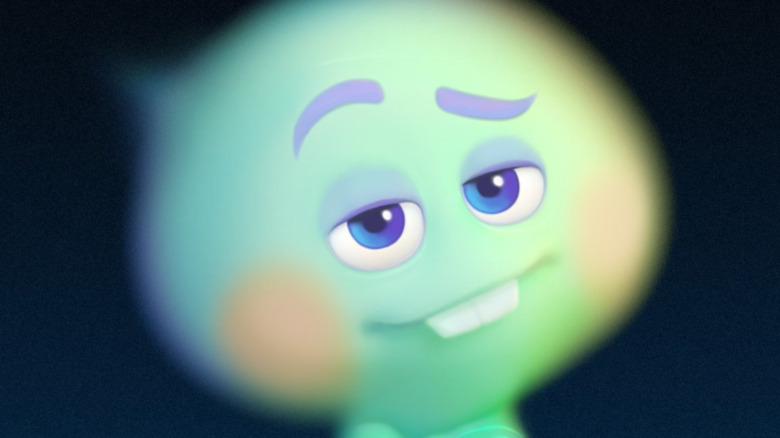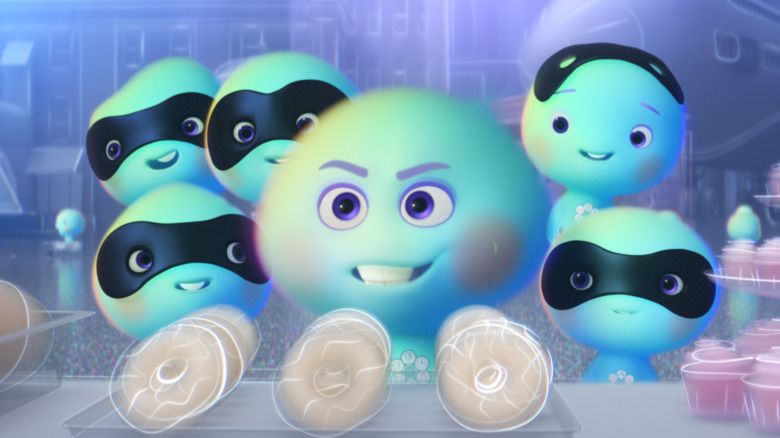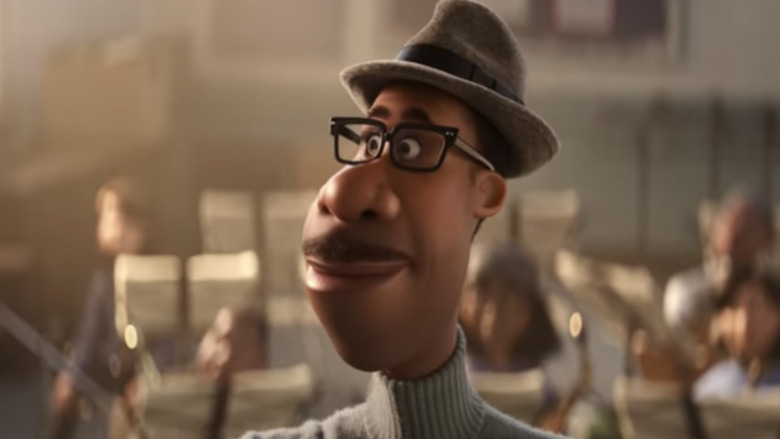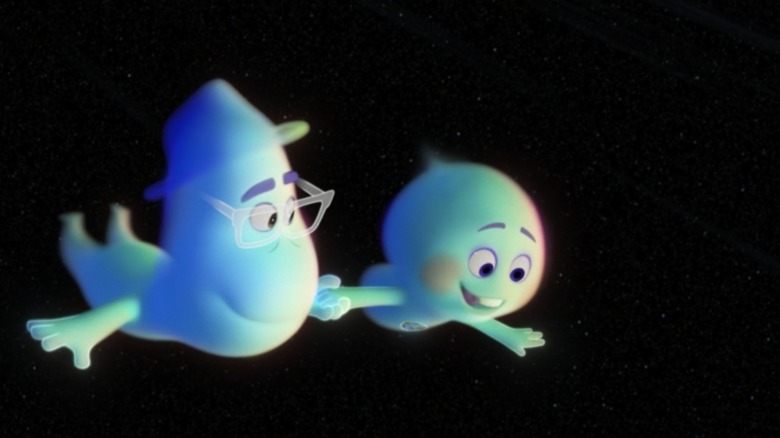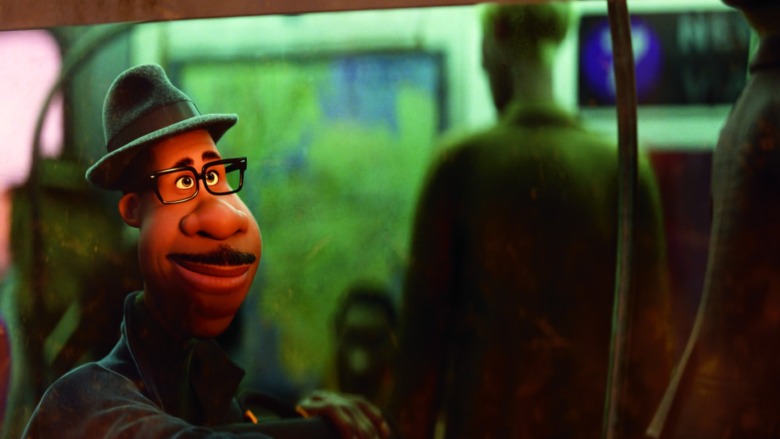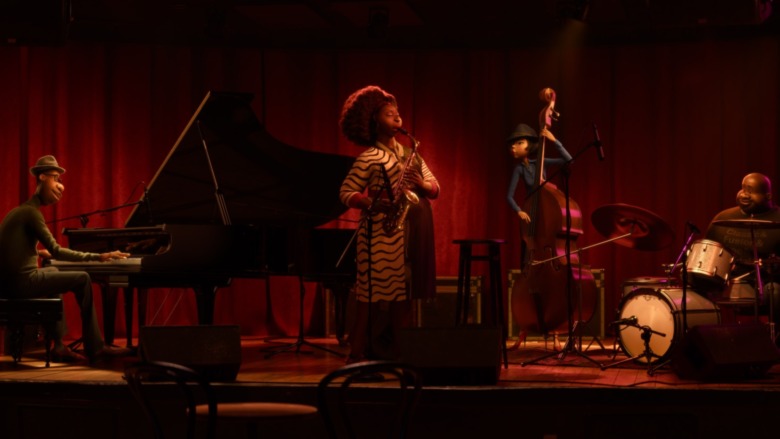Pixar Veteran Kevin Nolting On Directing The Soul Short 22 Vs. Earth - Exclusive Interview
Debuting at the end of a fraught 2020, the Pixar film "Soul" arrived precisely when audiences needed it the most. After almost a year of quarantining and dismal news, the creators of "Soul" treated viewers to an uplifting film that posed questions about existence, death, and the purpose of life. And while the animated movie answers many questions in its own way, it poses a few others, too. For instance, how exactly did 22 become so jaded?
Luckily for viewers, many of whom are still quarantining away from loved ones, the Pixar team is releasing a timely prequel centered around the character 22, voiced by Tina Fey. The short, titled "22 vs. Earth," is an exploration of our favorite jaded soul. And what's more, it's directed by Pixar legend and "Soul" editor Kevin Nolting. With an impressive editing resume filled with titles like "Up," "Inside Out," "WALL-E," and "Finding Nemo," it's safe to say that Nolting has had a hand in some of the most cherished animated films of recent decades.
Looper spoke with Kevin Nolting for an exclusive interview, in which he dished on working with Tina Fey, what it was like to go from editing to directing, what "Soul" fans will love most about the prequel, and just what it felt like to see the film snag a couple of Oscars.
Kevin Nolting is a Pixar legend
What do you think fans of "Soul" will love most about the prequel, and what questions were you hoping to answer or address with the follow-up?
I'm hoping they love the fact they learn a little bit more about 22. Just the way we get involved for us, as we were making Soul, we explored Joe's life in great detail, but the story didn't call for that amount of detail with 22 — other than those little snippets with the mentors. So, as we were making "Soul," certainly we talked a lot about what made 22, 22. We joked about it. We had a lot of funny ideas — incidents that led to the character she is. So, the short is just an extension of that, I think.
You're a Pixar legend, having worked on projects like "Up," "Soul," "Inside Out," "Toy Story 4," and now "22 vs. Earth." What have been some of your favorite moments from each of those films, and how does working on a shorter project like this compare to a full-length movie?
Well, my favorite, I don't know if it's a specific moment. I've said to people before I have one of the best jobs at Pixar. I get to hang out with Pete Docter and make movies. That's just like a day-to-day adventure. Picking specific moments within those movies, certainly, there's a lot of great, great things. I'm sorry, what was the second part?
What's it like working on a shorter project rather than a full-length movie?
So, [in] a full-length movie, there's an unlimited runway, so to speak. You can just go off on tangents. We're spending a lot of time exploring things that don't work out. It can be working on something for three, four, or five years. Honestly, it can get a little old sometimes. It's a very deliberate process in a lot of ways, a lot of churning and thinking and reworking. And a short for me, I've done a number of little 48-hour shorts, and it's so refreshing to have to make quick decisions and just produce something quickly and concisely. It's just great — another part of my brain to exercise.
A star-studded cast
How long did this one take from start to finish?
So, I think we started storyboarding in February 2020. I think animation lighting had wrapped by summer, late summer. And we mixed up at Skywalker mid-September 2020.
Were you able to work directly with Tina Fey, and what was that experience like?
Yes. I had been part of the recording sessions for "Soul." So, I've worked with her over the years, but the short, we recorded her in two weeks into COVID, work from home. So, everybody was getting used to zoom, and simply, we hadn't recorded a lot of dialogue remotely. So, fortunately, her husband has a home recording studio she could work out of, but she was like the rest of us: Her daughter was home from school, and she had to interrupt the session to go set her up with a remote class. It's like a little slice of life.
What about working with Jon Batiste and Jamie Foxx on "Soul"?
Oh, man. I mean, Jon Batiste, he's such a joy to be around. We were so lucky that, in this case, he started fairly early, so we got to spend a lot of time with him, and I can't say enough about how great that was. And Jamie Foxx, he's so funny and so much energy. Yeah, it was a treat.
Awards and realism
I think we all feel a little bit like 22 in quarantine, separated from friends and family. The "What is our purpose?" question and the loneliness that the short poses feel all that much more relevant during COVID times. Did any current events inspire this project at all?
No. I mean, to be honest, we conceived of it just weeks ahead of COVID quarantine. So, it's purely coincidental. If you look at Pete Docter's history, he has a knack for this kind of thing. "Monsters, Inc." was finishing just when 9/11 [occurred], like a month after 9/11 — and the themes on that were just so pertinent. So I don't know what it is.
Maybe a little bit of premonition going on in there. So, you're a long-time editor, but you put on your directing hat for this short. How did the two roles compare, and is directing something that you'd like to continue to do more of?
The two roles compare by definition — an editor is very judgmental in a good and a bad way. The material comes in, and our first reaction is to judge it, like "Yes, this is worthy [of being] in it, this is not," and we can be pretty harsh sometimes. Especially back in my light action days, looking at dailies coming in, editors can be really hard on [the] material. So, as a director, being the one judged all of a sudden is a really good life lesson.
Were you inspired by any other projects when directing the short? Did anyone give you any words of wisdom on directing?
I've been fortunate. I've had a front-row seat for 15 years watching Pete Docter direct, so that was my classroom, so to speak. I couldn't ask for more. So, it wasn't a matter of someone sitting me down and taking the info. It's more, how much did I learn from all of that?
From editor to director
Do you have one specific project that maybe helped you the most in preparing for it?
Well, I was fortunate, like I said, to watch Pete grow as a director, and I can learn from his mistakes over the years. As he matured, I could see what works and what doesn't work.
Congratulations on the Oscar wins for "Soul." You've worked on quite a few Oscar-winning projects. How did you react to the wins on Sunday? And does that ever get old?
No, it certainly doesn't get old. I just react like ... It's an honor to be recognized by your peers. It's a big thing.
What do you hope fans will take away from the prequel?
Yeah, I approach these things, same with the features. You just hope that people walk away asking questions or talking about them. So, that's all I can hope for.
There's a heavy emphasis on maintaining the realism of New York City within the animation of "Soul." How did you go about making sure things were accurate and realistic? And were you inspired by any other bodies of work in that regard?
Certainly, the art department did their research. We also did a research trip with Steve Pilcher, the production designer, to New York and just spent a few days absorbing it and went to jazz clubs and walked around the city. And he was constantly, Steve, it was hard to keep him in [control] because he was constantly sketching out the details. He was especially obsessed with the gum on the sidewalk, and there [were] photos of it. So, while we were working on the story for three or four years, the art department is busy, really delving into details.
The soul of Soul
Music is such a massive component of "Soul." How did you prioritize the spiritual elements of the music versus the realistic ones?
How I prioritize? Well, those things just sort of evolve. It's not a conscious thing. The first scene I cut was the ramp-up to the white light. So, I started using, actually, the "Arrival" score to start with before Trent Reznor and Atticus Ross came on, just sort of finding the tone. That's almost the key for me. And so the jazz, New York, we knew Jon Batiste was going to be doing the music, and [there was] going to be jazz. So, [he] and Questlove actually would feed us playlists to listen to, to inspire the musical tongue.
What does your process look like when you first sit down with a project and then right up until you finish?
My process as an editor, or just in general?
Specifically as an editor, but if you want to do director too, that works as well.
Unfortunately, as an editor with Pixar, we have this longer runway. So, the process of what we've worked out with Pete over the years is, we tend to start big and go into detail later. So, we'll spend the first six months or a year just doing the movie overall very quickly and not worrying about details and just trying to get the overall tone and the overall rhythms of the movie and where different emotional moments are going to be. And then we slowly worked into the details after that.
And were there any scenes that you struggled with cutting the most?
[In] both "Inside Out" and "Soul," the sort of introductory scenes where Pete comes up with these worlds that don't exist. How do you introduce the rules of that world to an audience who just wants to see a movie and you want to get on with the movie? But you have to set up the rules of the world and that [in] both movies, that was a huge, huge challenge.
Catch "22 vs. Earth" streaming on Disney+ on April 30.
